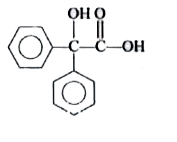Compound (A), C8H9Br, gives a white precipitate when warmed with alcoholic AgNO3. Oxidation of (A) gives a acid (B), C8H6O4. (B) easily forms anhydride on heating. Identify the compound (A).
_E01_924_O01.png)
_E01_924_O02.png)
_E01_924_O03.png)
_E01_924_O04.png)
The correct Answer is:D
Step by step video & image solution for Compound (A), C_(8)H_(9)Br, gives a white precipitate when warmed with alcoholic AgNO_(3). Oxidation of (A) gives a acid (B), C_(8)H_(6)O_(4). (B) easily forms anhydride on heating. Identify the compound (A). by Chemistry experts to help you in doubts & scoring excellent marks in Class 12 exams.
Topper's Solved these Questions
- BOOK - ALLENCHAPTER - ALKENE, ALKANE & ALKYNE EXERCISE - EXERCISE-5[B]165videos
ALKENE, ALKANE & ALKYNE
- BOOK - ALLENCHAPTER - ALKENE, ALKANE & ALKYNE EXERCISE - EXCERSISE-125videos
ALKENE, ALKANE & ALKYNE
- BOOK - ALLENCHAPTER - ALKENE, ALKANE & ALKYNE EXERCISE - EXERCISE-558videos
ALKENE, ALKANE & ALKYNE
- BOOK - ALLENCHAPTER - AIIMS 2019EXERCISE - CHEMISTRY40videos
AIIMS 2019
- BOOK - ALLENCHAPTER - ALKYL AND ARYL HALIDEEXERCISE - EXERCISE-05 (B)35videos
ALKYL AND ARYL HALIDE
Similar Questions
Compound (A) C8H9Br. Gives a white precipitate when warmed with alcoholic AgNO3. Oxidation of (A) gives an acid (B). C8H6O4. (B) easily forms anhydride on heating. Identify the compound (A)
View SolutionCompound (A) C8H9Br. Gives a white precipitate when warmed with alcoholic AgNO3. Oxidation of (A) gives an acid (B). C8H6O4. (B) easily forms anhydride on heating. Identify the compound (A)
View Solution
Knowledge Check
- Question 1 - Select One
An organic compound (A), C7H6O gives positive test with Tollen's reagent, on treatment with alcoholic CϴN,(A) yields the compound (B),C14H12O2. Compound (B) on reduction with Zn-Hg, HCl and dehydration gives an unsaturated compound (C), which adds on mole of Br2/CCl4. The compound (B) can oxidized with HNO3 to a compound (D), C14H10O2. Compound (D) on heating with KOH undergoes rearrangement adn subsequent acidification of rearranged products yields an acidic compound (E), C14H12O3.
Structure of compound (B) isA B
B C
C D
D
- Question 2 - Select One or More
An organic compound (A), C7H6O gives positive test with Tollen's reagent, on treatment with alcoholic CϴN,(A) yields the compound (B),C14H12O2. Compound (B) on reduction with Zn-Hg, HCl and dehydration gives an unsaturated compound (C), which adds on mole of Br2/CCl4. The compound (B) can oxidized with HNO3 to a compound (D), C14H10O2. Compound (D) on heating with KOH undergoes rearrangement adn subsequent acidification of rearranged products yields an acidic compound (E), C14H12O3.
Compound (A) cannot undergoABenzoin condensationBCannizzaro reactionCAldol condensationDPerkin - Question 3 - Select One
An organic compound (A), C7H6O gives positive test with Tollen's reagent, on treatment with alcoholic CϴN,(A) yields the compound (B),C14H12O2. Compound (B) on reduction with Zn-Hg, HCl and dehydration gives an unsaturated compound (C), which adds on mole of Br2/CCl4. The compound (B) can oxidized with HNO3 to a compound (D), C14H10O2. Compound (D) on heating with KOH undergoes rearrangement adn subsequent acidification of rearranged products yields an acidic compound (E), C14H12O3.
Structure of compound (E) isA B
B C
C D
D
Compound (A)(C6H8)[o]−−→ Malonic acid only. Identify compound (A).
View SolutionA compound (C5H8) reacts with ammoniacal AgNO3 to give a white precipitate and reacts with excess of KMnO4 solution to give (CH3)2CH−COOH. The compound is
View SolutionAn organic compound (A) (C8H14O) forms an oxime and gives a positive haloform reaction. On ozonolysis, it gives acetone and a compound (B) (C5H8O2) . (B) forms a dioxime and on subjecting to oxidation reaction gives an acid (C ) (C4H6O4). On treatment with excess of ammonia and strong heating, (C ) gives a neutral compound (D) (C4H5O2N). (D) on distillation with zinc dust forms pyrrloe. Suggest the possible structures of (A), (B), (C ), and (D). Explain the chemical reactions involved.
View SolutionCompound A(C9H10O) shows positive iodoform test. Oxidation of A with KMnO4/KOH gives acid B(C8H6O4) . Anhydride of B is used for the preparation of phenolphthalein. Compound A is:
View SolutionWith alcoholic potash, C4H8Cl2 (A) gives C4H6 (B), which reacts with ammoniacal cuprous chloride. Identify the compounds (A) and (B).
View Solution

